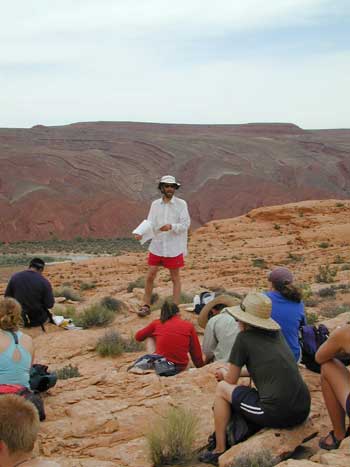
Michael Ort’s research reveals how smaller cinder-cone, or scoria-cone, volcanoes that effuse at low volume, have huge impacts on society.
His research is featured in the March issue of the Geological Society of American Bulletin and an upcoming issue of the Journal of Volcanology and Geothermal Research. Last week, his findings appeared on the Discovery Channel web site.
Living Under the Shadow, a new book about volcanoes published by Left Coast Press, devotes a chapter to Ort’s research at Sunset Crater in northern Arizona. Ort worked with numerous coauthors on the project, including NAU scientists Kirk Anderson and Wendell Duffield.
The recently published research focuses on how scoria-cone volcanoes can vary in eruption style, which determines how much they blanket the earth and affect environment and culture.
“This work sheds light on possible priorities for responding to small volcanic eruptions that occur where people live,” Ort said.
Ort and his colleagues compare the Parícutin volcano in Mexico, which erupted from 1943 to 1952, to Sunset Crater’s eruption about AD 1080. Through geological, archaeological and modern soil-testing techniques, they compare the effects the two volcanoes had on nearby human populations.
“Significant agricultural communities lived near each volcano and the eruptions’ effects upon agriculture were distinct,” Ort explained.
In the wetter environment of Mexico, the scoria limited agriculture and led to abandonment of a large area. At Sunset Crater, the scoria acted as mulch, and although land near the volcano was abandoned, it caused previously non-arable land to become fertile.
The research reveals that Sunset Crater communities that did not evacuate did better in the following decades than those forced to move or separate into new communities. It also shows how the altered land resulted in advancing farming techniques.
At Parícutin, the governments made people relocate. Many of these communities did not do well in the years that followed. With each volcano, people fared better to stay near their homes, cultural artifacts and community structures.
Although future volcanic eruptions will occur in Arizona, “they probably will not be in our lifetime,” Ort noted. “There is a recurrence interval of a few thousand years in the San Francisco volcanic field.”
Other active volcanic fields in Arizona are north of the Grand Canyon, in Springerville and at the state border near Grants, N.M.



